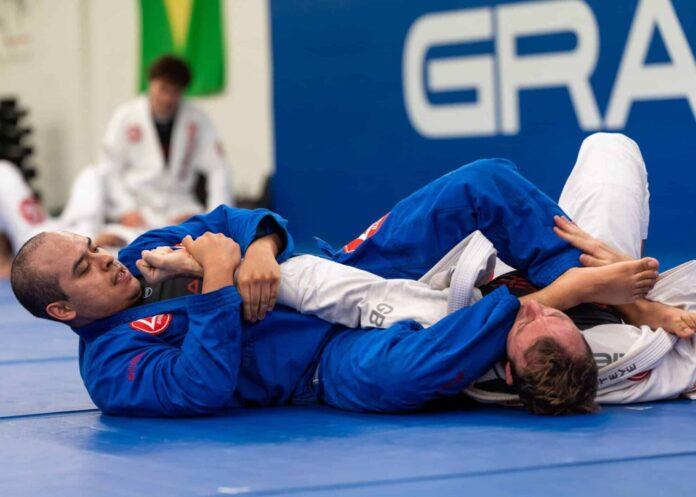
Jiu jitsu is an exciting martial art known for its use of grappling and ground-fighting techniques. Originating from Japan, it has evolved into a system where leverage and skill are key, allowing a smaller or weaker individual to successfully defend against a bigger opponent.
Unlike many other martial arts, jiu jitsu does not rely on striking or kicking, instead, it’s a chess match of body mechanics where practitioners learn to gain the upper hand through holds, locks, and submissions. Its effectiveness is celebrated worldwide, making it a cornerstone discipline in mixed martial arts (MMA) and self-defense.
The purpose of this article is to serve as a compass for beginner jiu jitsu enthusiasts, illustrating that muscle power alone is not the key – instead, it’s the mastery of technique that reigns supreme. For beginners, understanding the foundational techniques is wildly important; they form the building blocks of all advanced skills and strategies. In this article, we’ll explore the maneuvers and principles necessary to form a robust starting point in jiu jitsu, paving the way for growth and advancement.
Mastering Takedown Tactics ─ Securing the Dominant Position
Becoming adept at executing takedowns is necessary for gaining an advantageous position over an adversary. Takedowns are not just about getting an opponent to the ground; they are key maneuvers that enable a practitioner to transition from a neutral or defensive stance to one of control. For those new to the discipline, several foundational takedown techniques can be learned and perfected with practice.
Beginners often start with the single-leg takedown, where one opponent’s leg is grasped and used to unbalance them, or the double-leg takedown, a technique involving a simultaneous grab of both legs, often combined with a drive forward to force the opponent down. These are fundamental skills that, once mastered, serve as the cornerstone for more advanced and complex grappling maneuvers. As novices progress, they discover that a successful takedown doesn’t just put you in control; it can set the tone for the entire encounter, making it an important area of focus for anyone serious about their jiu jitsu progression.
Establishing Positional Control ─ Securing Advantage Points
With jiu jitsu, establishing and maintaining positional control is key to a practitioner’s success on the mat. This martial art places a major emphasis on the positional hierarchy, which serves as a roadmap for fighters to understand which positions offer them greater control and leverage over their opponents. At the heart of this hierarchy are positions that provide stability while limiting the opponent’s capability to counterattack or escape.
For beginners, it’s important to focus on mastering the basic positions such as the mount, where one sits atop the opponent; the guard, which allows control of an opponent from the bottom using the legs; side control, providing lateral dominance; and the back mount, which positions one behind the opponent. Mastery of these foundational positions lays the foundation for achieving dominant control, enabling one to apply submissions or transition to other advantageous positions confidently. As newcomers become skilled in these positions, they lay down the groundwork for their progression through this complex and rewarding discipline.
The Subtle Power of Submissions ─ When to Hold and When to Tap

In martial arts, the concept of submissions is a strategic tool that allows fighters to claim victory with finesse rather than brute force. Submissions are techniques designed to gently but assertively compel an opponent into conceding the match, typically by creating a scenario where continuing would mean risking injury. These maneuvers, fundamentally centered around joint locks or chokeholds, can be a silent whisper that speaks volumes in the heat of combat. For those just starting, understand a few basic submission techniques and how to apply them.
Beginners might learn the armbar, which targets an opponent’s extended arm, applying pressure between the wrist and elbow; or the rear naked choke, a technique that wraps the arm around the neck from behind, cutting off the blood supply to the brain. While the power of submissions is undeniable, it’s key for novices to practice under expert supervision, ensuring that they learn when to “hold” and perfect their technique, and more importantly, when to “tap out” to prevent unnecessary injury.
Escaping the Inescapable ─ Defensive Maneuvers
With martial arts, particularly jiu jitsu, becoming skilled at defense is just as important as learning a powerful offense. No matter how skilled a fighter is, they will inevitably find themselves in a precarious position, grappling with the need to escape. This is where the true value of defensive maneuvers becomes apparent. Every jiu jitsu beginner needs to familiarize themselves with fundamental escape techniques—practices that can transform the inescapable into a situation where they have control and can mount a comeback.
From shrimping out of a tight mount to the classic bridge-and-roll to evade a dominant opponent, these techniques are the building blocks for a resilient jiu jitsu foundation. They teach practitioners not only how to survive when the tides of battle turn against them, but also to understand the dynamics of control, turning defense into offense.
Bridging the Mind and Body ─ The Role of Mental Strategy

With jiu jitsu, the combination of physical prowess and sharp mental acuity often marks the difference between a novice and a master. Strategic thinking and anticipation are key pillars in this martial art, where foresight is just as important as the execution of a move. To maneuver through the opponent’s defenses, one must learn to predict their actions, turning fights into a chess match where each move is methodically planned.
Beginners are encouraged to spar with many partners, as this exposes them to different fighting styles and thought patterns, enhancing their ability to read and react to new situations. Keeping a reflective training journal can also foster a deeper understanding of one’s strengths and weaknesses, allowing for targeted improvements.
It’s important to recognize that mastery in this martial discipline is not achieved overnight. Patience and steady progress are the cornerstones of advancing in jiu jitsu. Every technique discussed, every position practiced, and every roll engaged in contributes to one’s growth on the mat. To beginners out there, absorb the knowledge and wisdom imparted by your instructors, peers, and the vibrant jiu jitsu community. Embrace the slow, incremental improvement as it is the essence of true learning. Recall that each session adds a layer to your understanding, and with each practice, you refine and polish your skills. Allow your dedication to be your guide and remain committed to this transformative path.








